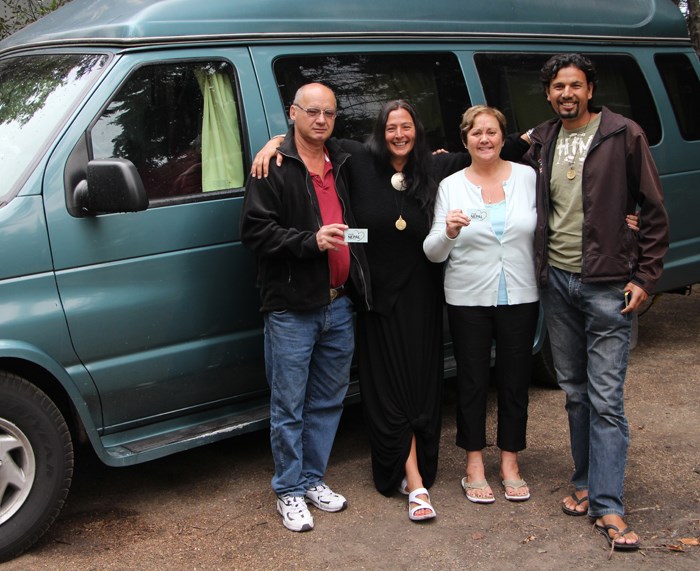In April of this year, Nepal was hit with a 7.8 magnitude earthquake, devastating the tiny country. With more than 9,000 people killed and 23,000 injured, the earthquake was the worst natural disaster to strike Nepal since 1934. Wendy Laroux and Buddhi Parajuli were in Nepal during the earthquake and were first responders in the crisis. Now, they are touring Canada to get people thinking about Nepal, whether funding relief efforts or considering taking a trip to the country, which relies on tourism.
When the earthquake hit, Laroux says they were constantly processing what was going on, keeping in mind what escape routes were in the area and finding the safest place in the area, finally standing in the middle of the garden.
“We just stood there and just felt this huge wave beneath us... The only thing we could do was just stand and hold each other, we just knew it was the big one.”
It had been known for years that Nepal was in a geologically unstable area, and there were constant small earthquakes. Laroux says that earlier in April she asked someone from YachtAid international about whether they would be able to help a landlocked country through delivering supplies via Calcutta, as the threat of a large earthquake in the country was always in the back of their minds. She says this became how she got support and advice while being part of the first responders, getting in contact with Mark Drewelow, the founder.
“He was walking me through a very rapid education on disaster relief. I’m very grateful to him, because in his words ‘you’re the only one in the world doing this right now... You’re walking into a world of the UN and NGOs, you’re going to have good days and bad days, you’re going to be exhausted, you’re going to see things that are going to make you want to vomit, are you sure?’ I said, ‘of course.’ You don’t even question that.”
While she had a knee injury from a motorcycle accident, Laroux worked to connect people, find missing relatives and get people to complete needs assessments so that the aid coming in could be distributed through the country. She says that the needs assessments were the biggest part of her job, because it was the only way to get aid to where it needs to go. As they still had a connection, both phone and internet, they used that to help as much as they could.
“In the middle of the night on the first night we had a call from Brazil. There was a traveller, a mother was trying to find her daughter, we were thankfully able to put them together as well,” Laroux says.
While her role behind the phones wasn’t as visible, it was necessary, and she says it was the best way for her to help with a knee injury.
“If I had been able to get in on the ground and help with hands on, I would have, but that became my role.”
Recovering from the earthquake isn’t just about the structures, but it’s about the people, Laroux says. She says that loud noises can still bother both of them, because they spent so many months dealing with aftershocks.
“We were suffering from post-traumatic stress as well because you’re on edge all the time. We couldn’t even imagine what Nepalis around the country were and still are going through, because we’re still affected.”
She says that for Canadians, it’s important to know what resources are out there if they are somewhere where disaster does strike. Laroux notes that in Nepal, the nearest Canadian Embassy is in Delhi, India, but that the American Embassy was able to help Canadians. She also notes that organizations like International SOS can help, and emphasizes that they are there for emergencies.
The decision to tour Canada was because they were independent, and wanted a way to continue to support Nepal after their first response role was less needed. They decided that by touring the country they could reach more people, and assist in the country’s recovery. Vive Nepal was born out of that desire, and after selecting two charities – Waves for Water to help with potable water, and Edge of Seven, a small organization rebuilding schools – they organized the effort to tour the country to get the word out about Nepal and help rebuild the country.
“After so much that we did after the earthquake hit, we just wanted to continue those efforts.”
She says that part of the goal is to keep people aware of Nepal after the news cycle has shifted on to other events. The other goal is to get people to reconsider travelling to Nepal. As the country’s economy is heavily built on adventure tourism, they need people to come to the country.
It’s a totally independent tour, and she admits that it has been a challenge to get the word out, even just securing a vehicle. But she says that they have had the good luck to make connections as they tour the country, with people like Cody and Brenda Denton at the City of Yorkton Campground allowing them to park for the night. They have had good luck as well, meeting a band in Yorkton at the neighboring campsite to plan for a future event when their paths cross in Alberta.
To get involved with the efforts of Vive Nepal visit www.vivenepal.ca.




